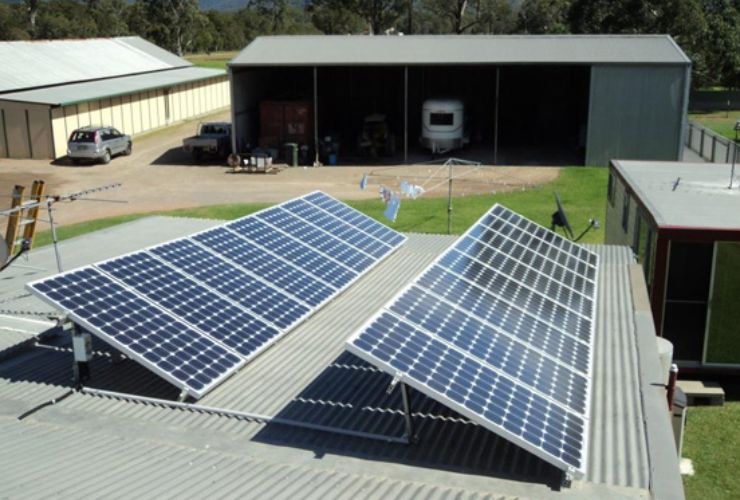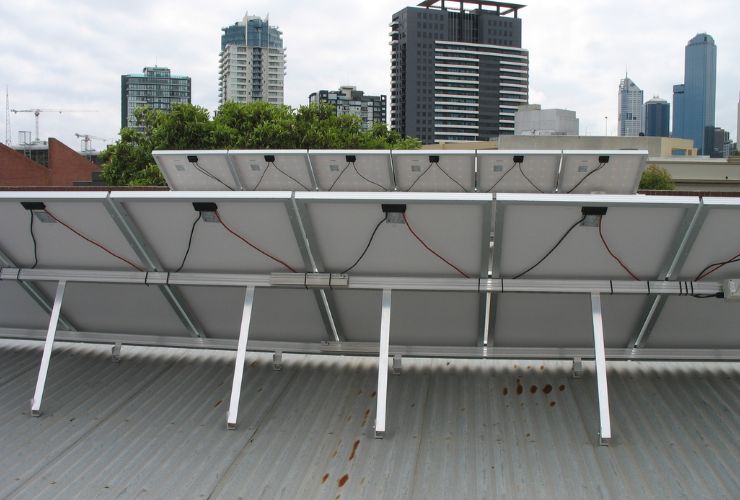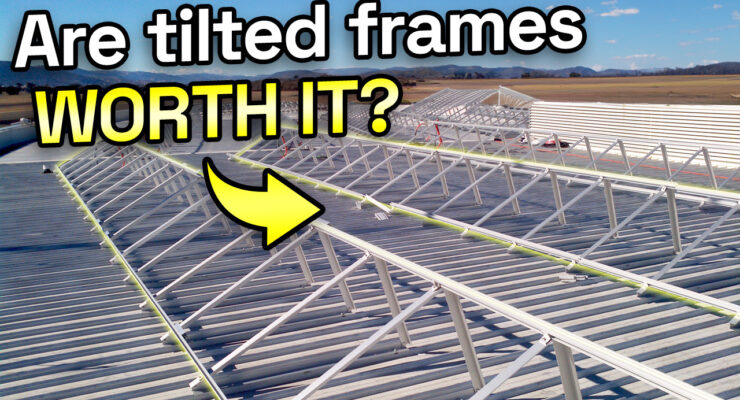Fast read
Solar panel tilt frames are a solution for homeowners with flat roofs who want to install solar panels. These frames allow the panels to be installed on an angle, increasing their output compared to when they are laid flat on the roof.
The optimal angle for solar panels varies depending on the season and the homeowner's electricity consumption. Tilt frames can provide benefits such as self-cleaning during rain, but they also have some disadvantages, such as adding to the cost of the solar system.
Homeowners should consult with a qualified local supplier or installer to determine if tilt frames are necessary for their situation.
Everything to know about solar panel tilt frames
If you are looking at purchasing your first solar system but have concerns as your roof is flat, solar panel tilt frames could be for you.
These frames allow you to install solar panels on an angle, on a flat roof space. This allows the panels to face the sun more directly and improve performance compared to laying on your top flat.
However, does the difference in output mean solar panel tilt frames are worth it? This FAQ will cover the best angle for solar panels, the benefits of installing the frame, and the cost of tilt frames.
What is the best angle for solar panels?
Solar panels create electricity for your home through sunlight. The more sunlight the panels get, the more output they can provide.
The more direct the sun is to the panels (i.e., perpendicular to), the more light the solar panel can receive and the more electricity can be created. So, ideally, you want the panels facing the sun as directly as possible, for as long as possible.
Usually, this is a satisfactory outcome because even if the panels do not generate the perfect 100% of possible output, the solar output generation losses one gets because of non-ideal pitch are usually less than 10% compared to the best possible scenario.
With panels being relatively cheap nowadays, the most common solution is adding more panels to compensate for any loss.

If you desire to maximise the output from your system
For example, if we have a 23-degree pitched roof, the most economical way is to have the panels fastened straight to the roof surface, which means they will also have a 23-degree pitch.
Things become interesting when you have a flat roof, as now you can install the panels flat or tilt frames to pitch the panels at an angle that maximises the output. This is because the angle of the sun changes between summer and winter. During summer in Australia, solar panels will have the highest output when installed close to a flat on the roof, as the sun is overhead.
But solar panels have the best output throughout winter if installed at a relatively high pitch, e.g. 30 degrees as the sun is on the horizon. To get the best total generation capacity over 12 months, the panels should be installed at a pitch/angle equivalent to the latitude of where you live.
So by capital cities, the latitude and optimal panel tilt/pitch (to the nearest degree) would be:
CityLatitude/ tilt angle (deg)Sydney33Melbourne38Brisbane27Perth31Adelaide34Canberra35Darwin12Hobart42
For standard pitch roofs with around 23 degrees, there would be no value in tilting the panels off the roof surface any further to reach the ideal angle, as the added performance is not likely to offset the increased installation cost.
The variance in optimal angles during the seasons means that each home’s “best” angle differs from season to season. Therefore, considering how your electricity use varies between seasons is also worth considering. To find what is best for your home, you must assess if you use more electricity during summer or winter.
During summer, you could use more electricity through pool pumps and air conditioning and therefore want the panels at a lower pitch. However, using heaters and staying home more during winter could result in increased electricity consumption, making a steeper pitch more preferable.
Your best bet is to assess your electricity consumption and consolidate with a solar professional to find the best angle for your unique situation.
The benefits of solar tilt frames
Best possible output
Now that you understand the influence the angle of your solar panels can have on the output of your solar panel system, you might wonder what to do if you have a flat roof.
This is where solar panel tilt frames come in. These allow your panels to sit on an angle no matter what and gain the ideal angle, which will maximise your PV output.
Self-cleaning
Another benefit is self-cleaning. The Clean Energy Council (CEC) has stated, “A minimum tilt of 10° is recommended to take advantage of self-cleaning during rain events”.
If you were to have a roof or solar panels below this angle, you might notice a build-up of water on them when it rains. This “pooling” of rainwater can result in the build-up of dust and dirt in those pooled areas, which can reduce the panel performance.
The most typical dust residues form on the bottom of the panel, especially in dusty areas. If this dust is not cleaned off from time to time, the solar cells in the bottom row of the panels will experience shading, which can lead to hotspots on the panel and panel failure over some period. The manufacturer’s warranty will not cover such a failure.
While this is the worst-case scenario, the dust will, at a minimum, reduce the panel output. In such a setup, you must get a panel cleaning professional onto the roof every two years to clean the panels. If you were to have a solar panel tilt frame, the rain would run off the panel, and you would not have to have the panels cleaned as often.

The disadvantages of solar panel tilt frames
1. They can be more expensive
The average solar panel’s tilt frame cost, such as the legs and extra labour, can add to $1000 for an average residential system and more for large systems. Within such a budget, it’s easy to add a few more panels, thereby compensating for the electricity lost because of the less-than-ideal angle by increasing the system size.
2. Tilt frames can cause shading issues
If the tilt frame installation does not space the rows of panels sufficiently apart, the front row in the early morning or late afternoon can overshadow the back row. This will cause a regular loss of output, usually when we seek to maximise PV output, as the system output at that time will already be low.
These sharp shadows, especially in a string inverter, can cause hot spots of blown bypass diodes.
3. They can make the solar PV system size smaller
Tile frame rows need a minimum spacing from each other to prevent overshadowing the back row by the front row of panels during low sun angles. Consequently, fewer panels can be installed in a tilt frame system.
So, if you have a limited overall roof size but a flat roof, placing the panels flat on the roof and allowing for a narrow access gap will enable you to have a larger solar power system.
In summary
- Follow the roof line for roofs with a pitch, and do not bother with tilt frames.
- If you have a large flat roof, such as in a commercial system, and want to save on panel cleaning while maximising the output in the long run, tilt frames are a good option.
- If your roof size is limited and you are on a budget, then flat on the roof, with a minimum angle of 5 degrees, is acceptable. But under this scenario, please allow for more regular maintenance regarding panel cleaning.



